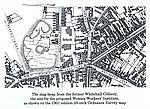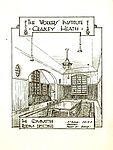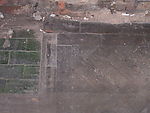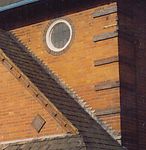 Architect's Drawing - Exterior
Architect's Drawing - Exterior Map showing the slag-heap on which the Institute was built
Map showing the slag-heap on which the Institute was built Architect's Drawing - Meeting Room
Architect's Drawing - Meeting Room Ornate Tile sign on the front of the Institute building
Ornate Tile sign on the front of the Institute building A Bound Bundle of sticks ?
A Bound Bundle of sticks ? Fireplace
Fireplace  Typical Flooring
Typical Flooring Decorative Brick Work
Decorative Brick Work

The Cradley Heath Workers' Institute was built in the Arts and Crafts style.
The Institute's steeply pitched, tiled roof with gables and dormers, decorative brick and tile work and leaded windows, are typical of the Arts and Crafts style of architecture. It is an unusual style to be found in the Black Country, though we believe there are other Workers’ Institutes around the country of similar design. The low geometric roof line is typical of the Gothic revival, a movement drawing on mediaeval influences. A romanticised view of the Middle Ages was a great inspiration to much of the Arts and Crafts Movement. Much of the construction of an Arts and Crafts building was left exposed, giving an honesty and acknowledgement to the skill of the construction.
Arts and Crafts buildings often have decorative exteriors. The pictures show an ornate tile sign depicting a symbol, possibly of a bound bundle. This is similar to the bundle shown on the National Federation of Women Workers' poster. Does the bundle represent the bound iron rods that were delivered to the workshops to later become chains? Or does it represent the strength of the women standing and fighting together? As Mary Macarthur would tell crowds at the time of the 1910 strike, “a bundle of sticks is much stronger when bound together.”
Though there is limited evidence of the original interior decoration, the architect's sketch shows a simple, stylish scheme. The interior is most likely to have been designed "fit for purpose", a vital part of Arts and Crafts philosophy, probably giving a simple well planned interior suited to the use as a meeting hall, office, leisure and entertainment space. The "jigsaw" tiled fireplace is a style which can be found in other Arts and Crafts buildings such as Blackwell, the Arts and Crafts house in Cumbria. The flooring is another example of Arts and Crafts style, with natural wood parquet flooring meeting floor tiles of a distinctive olive green, a popular colour used in Arts and Crafts interiors . The arch in the meeting room demonstrates the gothic influence found in the Arts and Crafts style.
It is not known why the Arts and Crafts' style was chosen for the Institute, but there are a number of links to be made, which might help to explain it. The Arts and Crafts Movement supported handicrafts and the well being of workers. Was the style considered appropriate then, because the Institute was to be built using the surplus money from the strike fund of skilled, hand-made chain makers, and because it was intended to improve the lives of Cradley Heath's working women?
We can only speculate on why the architect, Mr. A.T. Butler, chose to submit an Arts and Crafts design. We do not know if, or how involved he might have been in the Movement, but it is likely that he would have had connections with it. He was a member of the Royal Institute of British Architects, based at the Birmingham and Midland Institute. At the time Birmingham had a very active branch of the Arts and Crafts Movement. He was also a member of the Worcestershire Council for the Preservation of Rural England, which shared many of the same ideals with the Arts and Crafts Movement.
The Arts and Crafts Movement was most active between 1880 and 1920 and was an ideology rather than simply a design style. The Movement rejected the mass production and pollution of the Victorian Age, and aimed to encourage and reinstate handicrafts and the use of natural materials and forms. The most well known name of the Arts and Crafts Movement is William Morris, as his designs and writings are still used and popular today. He himself was inspired by the beliefs and ideals of John Ruskin, an art critic and philosopher (himself influenced by the ideals of Pugin), Charles Kingsley, novelist and historian, and Edward Carpenter, poet and activist. They all held a strong belief in social reform for the down trodden of society, be they women, manual workers or homosexuals.
Augustus Pugin worried about the industrialisation of society and this leading to craftsmen becoming dissatisfied, as they no longer had the pleasure and satisfaction of seeing an object built from start to finish. He felt machines had their place in doing mundane, jobs requiring no skill, but not in replacing craftsmen.
John Ruskin was heavily influenced by Pugin, and began to campaign to return British crafts back to nature, using local materials and influences. He wanted to discourage the heavy French influence in Victorian design and reinstate the British mediaeval styles and crafts. He was a prolific art critic, who later became a political commentator. His theories about social justice later came to influence the policies of the Christian Socialist Party and the British Labour Party.
Charles Kingsley had great social conscience. His book, 'The Water Babies', demonstrates his concern for the working conditions of the poor and for the environment. In 1848 he, along with John Malcolm Ludlow, Frederick Denison Maurice, and others, formed the Christian Socialist Movement. He wrote many articles relating to his concerns, some under the pseudonym Parson Lot. In 1872 he was president of the Birmingham and Midland Institute, set up in 1854 for, "the Diffusion and Advancement of Science, Literature and Art amongst all Classes of Persons resident in Birmingham and the Midland Counties."
Edward Carpenter developed his socialist sympathies after reading, in 1868, a copy of Walt Whitman's poems "Leaves of Grass". He became very passionate about enabling the working classes to become educated and lodged with a working class family for some years, whilst working as a lecturer in Sheffield. He became involved in raising support for the Walsall Anarchists in 1892. He also became interested in Eastern religions, and began wearing sandals following a trip to Ceylon and India in 1890. This interest and habit led him to be ridiculed by some politicians in later years. Carpenter’s greatest influence was in his writings and openness about is sexuality. He is still seen as a hero in the gay liberation movements of today.
William Morris is best known as the leading name of the Arts and Crafts Movement. He set up companies and groups to support and encourage the handicrafts that he felt were being destroyed by the industrialisation of Britain. Morris was also an author, (he declined the post of Poet Laureate in 1892), artist and skilled craftsman in a range of mediums. In 1877 he founded the Society for the Protection of Ancient Buildings, as he had become despairing of the renovation of ancient buildings, which destroyed their character and features. He was one of the leaders in setting up the Socialist Movement in the 1880s, and was active in writing and lecturing for the cause of social reform.
Morris famously said, “Have nothing in your home that you do not know to be useful or believe to be beautiful”. This demonstrates that the Movement was interested in reforming daily life, wanting to enable everyone to have access to beautiful and well made goods. Victorian style, considered to be overly dark, fussy and unnecessarily decorative, was actively dismissed and replaced with a lighter and more natural style. Living habits were changed, the parlour became the living room. It was no longer seen as necessary to have a formal room, a house was for living in and enjoying comfortably. The Movement, by its belief in social reform, saw women for the first time as important both as artists and as customers. Women’s clothes became less restrictive and looser fitting, as the pre-Raphaelite paintings of the time show, again a movement back to a romanticised mediaeval style.
There were many pioneering women artists, who became famous due to the Arts and Crafts Movement, Georgia Gaskin - Jewellery, Edith Dawson – Jewellery, Katherine Adams - bookbinding, Wilhelm-Mina Geddes - Stained Glass, Margaret Macintosh-Macdonald - Textiles.
In his work, entitled, "Love's Coming-of-Age", Edward Carpenter writes, " the freedom of woman-which means, of course, the freedom of the masses of the people, men and women, and the ceasing altogether of economic slavery. There is no solution which will not include the redemption of the terms free women and free love to their true and rightful significance. Let every woman whose heart bleeds for the sufferings of her sex, hasten to declare herself and to constitute herself, as far as she possibly can, a free woman"
A number of Arts and Crafts communities were set up around the country to enable people to escape the busy industrial life of the cities and to go back to "simple" living. Millthorpe in Derbyshire, home of Edward Carpenter and life partner George Merrill, who lived together openly, though the seclusion of Millthorpe must have helped them to avoid the outcry and prejudice suffered by other homosexuals at this time. Others include, Ditchling in Sussex, home to Eric Gill, and Sapperton in the Cotswolds, home to E. Gimson and S. and E. Barnsley.
There were other communities around the country. These communities became meeting places for groups of artists and like minded people. The communities worked with varied success.
Garden cities became a model for town planning in the late 1890s. They were obviously a development of the Arts and Crafts communities, believing that a self contained and self sufficient lifestyle was possible and ideal, giving a balance between industry, agriculture and residence.
Arts and Crafts was a worldwide movement that still has relevance and influence today. That Cradley Heath, in the heart of the Black Country, was included in the Movement by the building style of the Institute, is intriguing and exciting.
Rollover the captions in the box to see the available images in thumbnail format, click the caption to see the full-size image
| Reference: | 662 |
| Keywords: | |
| Archive Ref: | 2004/768/001 |
| Updated: | Thu 22 May 2008 - 1 |
| Interpretation written by | Jenny Ermoyenous |
| Author's organisation | Curatorial |
| Organisation's website |